The end product of glycolysis is pyruvic acid. The fate of pyruvic
acid depends on the presence or absence of oxygen. If oxygen is present,
pyruvic acid can move into the Kreb Cycle (discussed later) where
it is oxidized into CO2 and H2O.
If oxygen is absent (anaerobic respiration), pyruvic is reduced and the
end products are CO2 and ethanol (alcohol, wine) during
fermentation in plants or lactic acid (sore muscles) in muscle cells.
In your notes draw a road map listing the organic molecules in a step wise
fashion used during fermentation. Upon completion of this "road map",
draw a input/output box in your notes indicating what enters
and leaves this pathway. Include the organic molecules and the biological
energy.
Study behavioral objectives 18-19
and read the pages indicated by E-7.
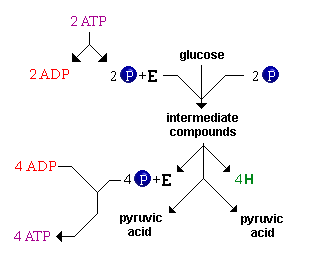 In
glycolysis, you studied the seven steps in the process by which cells extract
chemical energy from glucose. By means of the initial stages in carbohydrate
metabolism, the cell extracts enough energy to produce two ATP energy-storage
molecules and two NADH molecules (represented by the green H above ) per
glucose sugar molecule. Study the summary diagram above of those
seven steps.
In
glycolysis, you studied the seven steps in the process by which cells extract
chemical energy from glucose. By means of the initial stages in carbohydrate
metabolism, the cell extracts enough energy to produce two ATP energy-storage
molecules and two NADH molecules (represented by the green H above ) per
glucose sugar molecule. Study the summary diagram above of those
seven steps.
In the next web page during the citric acid cycle, you will see how the process of oxidative respiration enables the cell to extract essentially all of the chemical energy which remains in the end products of those seven steps-two pyruvic acid molecules and four hydrogen atoms. As long as oxygen is available, the process of aerobic carbohydrate metabolism continues via the pathway of oxidative respiration. This path makes possible the complete breakdown of sugar to carbon dioxide and water.
But not all organisms have a ready and constant supply of oxygen. Many yeast and bacterial cells live in environments in which oxygen is in short supply or completely lacking. In such cases, the cell must turn to fermentation as its principle means of obtaining needed chemical energy.
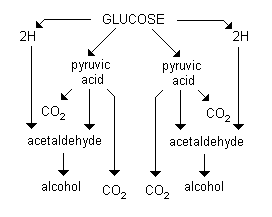 In
fermentation (anaerobic respiration) , the seven steps illustrated above
also occur. After the pyruvic acid, ATP and NADH are produced, the
cell rearranges the products of the initial seven stages to produce a set
of stable molecules. Look at the illustration of the entire fermentation
process above.
In
fermentation (anaerobic respiration) , the seven steps illustrated above
also occur. After the pyruvic acid, ATP and NADH are produced, the
cell rearranges the products of the initial seven stages to produce a set
of stable molecules. Look at the illustration of the entire fermentation
process above.
Take a close look at the reactions occurring in the two-step process
which transforms the pyruvic acid and hydrogen to alcohol and carbon dioxide.
Study the figures indicated by E-8.
Step 1:
- pyruvic acid ---> acetaldehyde + carbon dioxide (word form)
- C3H4O3 ---> C2H4O + CO2 (symbol form)
- acetaldehyde + NADH ---> alcohol + NAD (word form)
- C2H4 + NADH ---> C2H6OH + NAD (symbol form)
- Note: one NADH is used up per pyruvic acid molecule
- sugar ---> alcohol + carbon dioxide + energy
- C6H12O6 ---> 2C2H5OH + 2CO2 + E (stored in 2 ATP molecules)
Since yeast does not have any oxygen available during brewing, it must use the process of fermentation to obtain the energy it needs.
The fermentation process used by the yeast yields the alcohol the brewer is interested in. The carbon dioxide produced by the reaction is allowed to escape from the fermentation vat. If a brewer wants to control the amount of alcohol in a product (beer, 4 to 6%; wine, 10 to 12%), it is clear that he/she must control the amount of sugar in the original solution.
The amount of sugar made available to the yeast will limit the amount of all products of fermentation-the alcohol (for the brewer), the carbon dioxide (as waste), and the energy (for the yeast). The yeast cells will die after a while if more sugar is not made available to them. Why?
Answer: They need the energy to survive.
Yeast is a good example of a creature which uses the process of fermentation very effectively. The process certainly works well, for there are numerous creatures that use it to the exclusion of all other energy-liberating processes. But how does fermentation as an energy-liberating process compare with aerobic respiration ? Look at the illustration below, which shows both processes for metabolizing a glucose molecule.Respirtion which produces 38 ATP in the table below will be studied on the next web page.
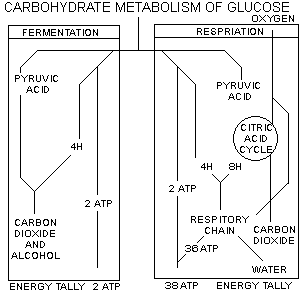
Which statement best describes the amount of energy derived by the two methods? (Click one.)
- a. Fermentation yields about the same energy as does oxidative respiration.
- b. Fermentation yields less energy than does oxidative respiration.
- c. Fermentation yields far less energy than dues oxidative respiration.
Answer: The chemical energy stored in the pyruvic acid and the hydrogen atoms.
As you will learn in the next section, oxidation of the two pyruvic acid molecules produces sufficient energy to convert thirty-six ADP molecules into ATP. Thus the oxidative respiration of one glucose molecule provides the cell with thirty-six more storage units of energy than does the fermentation of one glucose molecule. The illustration provides a simple summary of the two energy-extraction processes.
As you can see, compared to respiration, fermentation is shown to be a very inefficient process of energy-extraction for a cell.
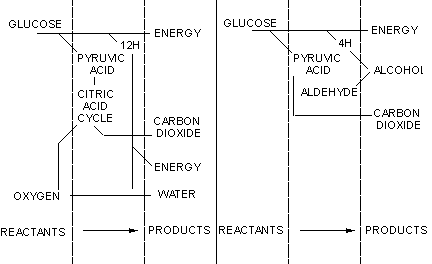
Energy is a necessity of life; to the cell, the energy which can be obtained from each molecule of organic fuel is very important. The cell has evolved the mechanisms for extracting, through a complex series of chemical reactions, all the chemical energy stores in the organic fuel it produces or takes in as food.
Respiration, photosynthesis (in which the sun's energy is transformed into chemical energy in complex organic fuels), and the energy-exchange process of the AMP/ADP/ATP molecular systems are all examples of very complex biological processes. These complex mechanisms, through which living matter obtains, stores, and uses energy, have all evolved because they are effective means through which life can be sustained and perpetuated.
The story of life is the story of the use of energy. Deprived of the mechanisms for using readily available energy, all living matter would immediately succumb to the trends described by thermodynamics-without energy to build and maintain complex structures, living matter could not remain highly organized and dynamic. Life would quickly slip into static disorganization.
Photosynthesis locks up the energy of the sun in highly organized organic molecules. This energy can be unlocked by both plants and animals via the processes of fermentation and respiration. All living matter engages in the continual quest for energy in usable forms. The struggle for life is best expressed as a struggle for energy.
Look at this illustration of the complete process of fermentation:
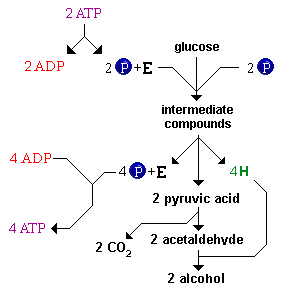
Note: The NADH (green H) formed during glycolysis are used up during the last step of fertilization. Since glucose was broken into two pyruvic acids, two carbon dioxides and two alcohols will be formed during fermentation.
1. The first seven steps of fermentation are exactly the same as the initial seven steps of oxidative respiration. (Click T or F.)
2. In Step 8, energy is:
- a. liberated
- b. used
- c. neither used nor liberated
- a. used
- b. liberated
- c. neither used nor liberated
- a. was liberated during the first seven steps
- b. was used up by the cell
- c. is still to be liberated in further steps
- a. fermentation yields about the same energy as oxidative respiration
- b. fermentation yields less energy than oxidative respiration
- c. fermentation yields far less energy than oxidative respiration
- Fermentation produces a net of 2 ATP.
- This is the end of lesson five. Click here to go back to the home page and lesson six Respiration - Krebs Cycle. click
input/output box
(write in your notes and learn)
Organic Molecules - Input: one glucose
Output: 2 ethanol and 2 carbon dioxide molecules
Energy Output - ATP ( 2 used during activation
and 4 synthesized = net of 2)
NADH (none, 2 formed during glycolysis but used during
the last step of fermentation)
Created by the Multimedia
Development Lab, Academic Technology Services.
Last modified October 29, 1997.